 This genus of fifteen to twenty-five species is native to Europe, Asia, and north Africa and belongs to the family Caryophyllaceae, also known as the pink or carnation family. The plants are biennials or short lived perennials, have bright red, orange or rose colored flowers that are carried singly, in twos or in clusters. Each flower has four to five petals that are notched, rounded, or fringed at the tips. The leaves are roundish and often hairy. Plants are well branched and grow twelve to twenty four inches tall. The genus name Lychnis may come from the Greek word lychnos meaning lamp, and refer to the ancient use of leaves of woolly species for wicks.
This genus of fifteen to twenty-five species is native to Europe, Asia, and north Africa and belongs to the family Caryophyllaceae, also known as the pink or carnation family. The plants are biennials or short lived perennials, have bright red, orange or rose colored flowers that are carried singly, in twos or in clusters. Each flower has four to five petals that are notched, rounded, or fringed at the tips. The leaves are roundish and often hairy. Plants are well branched and grow twelve to twenty four inches tall. The genus name Lychnis may come from the Greek word lychnos meaning lamp, and refer to the ancient use of leaves of woolly species for wicks.
Lychnis like average to fertile, evenly moist well-drained soil and full sun to part shade, with afternoon shade necessary in the South. Root rot can be a problem in wet soils, especially in winter. Deadheading prolongs bloom, and cutting back in late summer keeps the plants looking good most of the summer. All species may be easily propagated by seed.
Arkwright’s Campion (L. x awkwrightii)
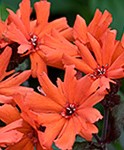 A hybrid between Maltese cross ( L. chalcedonica) and Haage campion (L x haageana), this hybrid has bright orange-scarlet flowers, 1 ½” wide carried in small dense clusters above dark brownish-green leaves.
A hybrid between Maltese cross ( L. chalcedonica) and Haage campion (L x haageana), this hybrid has bright orange-scarlet flowers, 1 ½” wide carried in small dense clusters above dark brownish-green leaves.
Size: 18-24’ h x 12” W
Bloom Time: Early summer
Hardiness: Zones 6-8
Maltese Cross (L. chalcedonica)
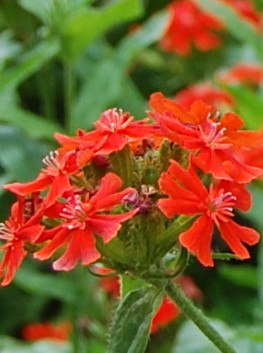 The ½’-l” wide scarlet flowers are carried in rounded dense clusters of twenty to fifty. The four petals are deeply notched and are arranged like a cross. The dark green leaves are 2-4” long and often clasp the coarse hairy stems. Plants are tall and may need staking. In full sun with ontant soil moistre this species is the most persistent.
The ½’-l” wide scarlet flowers are carried in rounded dense clusters of twenty to fifty. The four petals are deeply notched and are arranged like a cross. The dark green leaves are 2-4” long and often clasp the coarse hairy stems. Plants are tall and may need staking. In full sun with ontant soil moistre this species is the most persistent.
Size: 24-36” H x 18” W
Bloom Time: Summer
Hardiness: Zones 3-9
Rose Campion (L. coronaria)
 The magenta flowers are 1-2” across and carried singly or in small clusters of two to three. The foliage is wooly and gray-white. This species does well on lean, dry soil but is not persistent and should be treated as an annual of biennial. White, soft pink, and carmine-red varieties are available.
The magenta flowers are 1-2” across and carried singly or in small clusters of two to three. The foliage is wooly and gray-white. This species does well on lean, dry soil but is not persistent and should be treated as an annual of biennial. White, soft pink, and carmine-red varieties are available.
Size: 24-36” H x 18” W
Bloom Time: Spring
Hardiness: Zones 4-8
Ragged Robin (L. flos-cuculi)
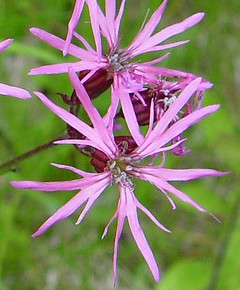 Rose to pink flowers with deeply cut petals are carried in clusters above a rosette of grass-like gray-green leaves lasting six to eight weeks. Ragged robin likes full sun and plenty of moisture. Dwarf and double flowered varieties are available.
Rose to pink flowers with deeply cut petals are carried in clusters above a rosette of grass-like gray-green leaves lasting six to eight weeks. Ragged robin likes full sun and plenty of moisture. Dwarf and double flowered varieties are available.
Size: 12-24” H x 12” W
Bloom Time:Summer
Hardiness: Zones 3-8
Haage Campion (L. x haageana)
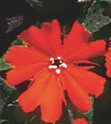 A cross between L. fulgnes and L. cornata var. sieboldii, this hybrid bears two inch wide orange-scarlet flowers in loose clusters of two and three. Each flower has two-lobed petals bearing small teeth on the margins. Dark green leaves two to four inches long are carried on hairy stems. Plants may go dormant in summer after blooming. A slug magnet.
A cross between L. fulgnes and L. cornata var. sieboldii, this hybrid bears two inch wide orange-scarlet flowers in loose clusters of two and three. Each flower has two-lobed petals bearing small teeth on the margins. Dark green leaves two to four inches long are carried on hairy stems. Plants may go dormant in summer after blooming. A slug magnet.
Size: 10-18” H x 12” W
Bloom Time: Summer
Hardiness: Zones 3-9
German Catchfly (L. viscaria)
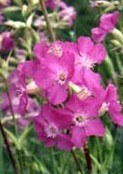 One inch wide magenta flowers grow in loose clusters of three to five above grass like foliage forming tufts. The flower stalk is sticky. Red, white, salmon, and double varieties are available. More tolerant of dry conditions that most other species.
One inch wide magenta flowers grow in loose clusters of three to five above grass like foliage forming tufts. The flower stalk is sticky. Red, white, salmon, and double varieties are available. More tolerant of dry conditions that most other species.
Size: 12-18” H x 12” W
Bloom Time: Early summer
Hardiness: Zones 3-8